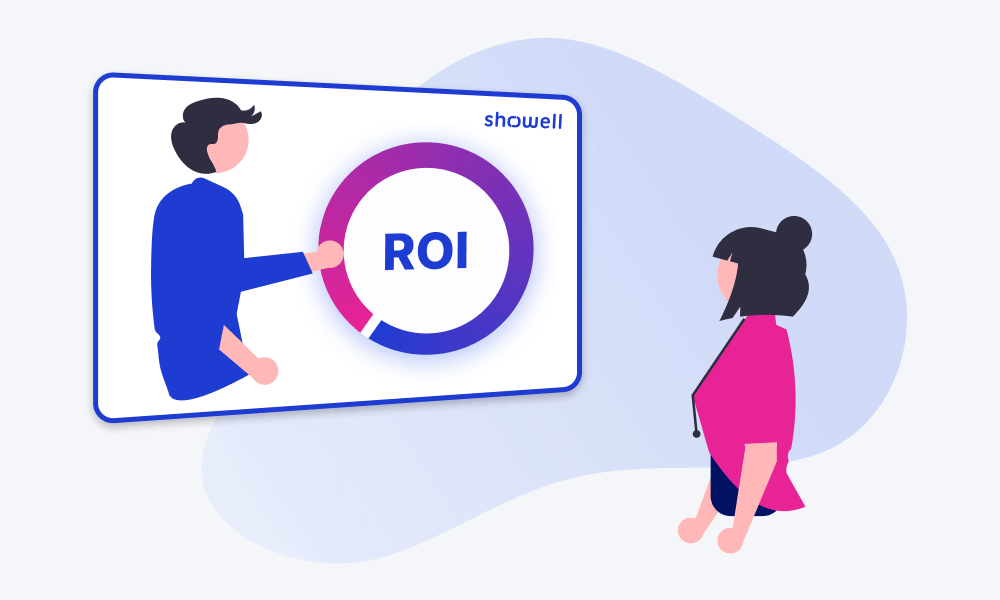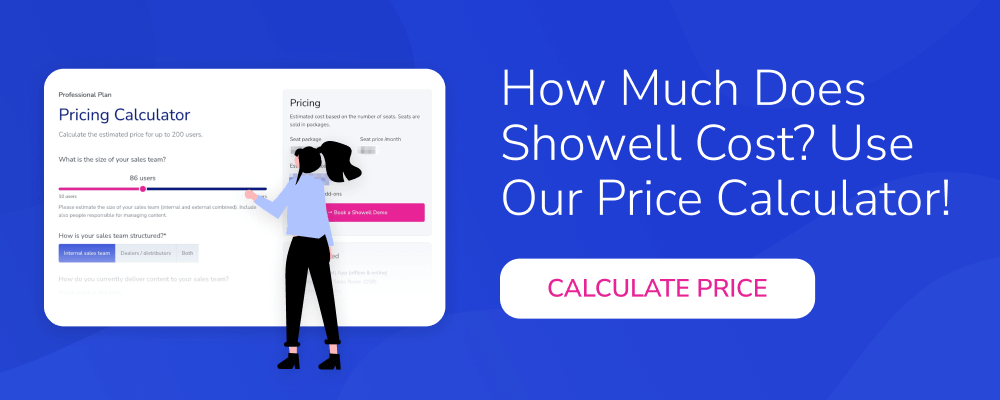Preparing for a sales call is your opportunity to lay the groundwork for a successful conversation. Much like creating a game plan, it’s about being intentional: setting clear goals, researching your prospect, and structuring your approach to ensure every interaction moves you closer to a deal.
If you've been wondering how to prepare for a sales call effectively, this guide will walk you through seven essential steps. Whether you're trying to set up a follow-up meeting, introduce a new solution, or close the deal, these actionable tips will help you approach every sales call with confidence and purpose.
Let’s dive into the key elements of preparing for a sales call that will improve your success rate.
Table of Contents:
1. Set Clear Goals for a Sales Call
Setting clear goals is akin to marking your destination before starting a journey. It provides direction and clarity, helping you to decide what is important and what is not and how to use your effort.
Precisely defined personal goals have been observed to enhance individual performance.
Furthermore, goal-setting is more than just an administrative task. It's a powerful self-leadership tool that drives success. Based on multiple research, precisely defined personal goals have been observed to enhance individual performance.
Without a clear target in sight, you'll have to settle for whatever comes your way, but settling is a far cry from the art of professional selling. Establishing clear objectives allows you to concentrate your efforts, reflect, learn, maintain motivation, and measure progress effectively.
Even though not every sales call aims to close the deal, it's still important to set practical and realistic goals for each interaction touchpoint with your prospect. These goals help you move forward towards either closing the deal or deciding when it's time to stop, saving you from spending too much time on a dead end.

Here are a few practical examples of goals you can set for your different sales calls:
Goal: Establish a Relationship
When reaching out to a prospect for the first time, your aim could be to build rapport and set the groundwork for future discussions. As a concrete goal, this might mean, for example, connecting on LinkedIn or setting up a subsequent meeting to discuss industry trends, exchanging valuable insights, or providing unique value in another way.
It's all about cultivating trust and establishing a solid foundation for potential business dealings down the line.
Goal: Gather Key Information
To effectively assist a buyer during their journey, you must deeply understand their specific needs and circumstances. As a concrete goal, your aim could be to uncover the different layers and aspects of their business operations, needs, and reservations like:
- budget
- desired timeline
- influential decision makers
- pressing pain points
- overarching challenges
- present solutions
- potential barriers to implementation
Goal: Schedule Another Meeting
Designating the objective to schedule a subsequent meeting can be a significant catalyst in fostering engagement, propelling the sales process forward, and cultivating enduring relationships with prospects. By proactively arranging another meeting or touchpoint, you exemplify your dedication and dependability while carving out avenues for an additional qualification, personalization, and sustained dialogue.
If you aim to close the deal, securing a follow-up sales call should always be part of your minimum goal for each conversation.
Goal: Introduce a New Product or Feature
If you're calling an existing client, your goal could be to introduce a new product or an upgrade to an existing one.
Goal: Close the Deal
Sometimes, your goal might be to finalize a deal that's been in the works. The conversation would then revolve around ironing out the last details and overcoming any remaining objections.
In essence, establishing distinct and precise objectives before each sales call serves as a valuable compass, directing the conversation, maintaining concentration, and enhancing the probability of attaining the desired outcomes.
Regard these goals and sub-goals as a navigational map, aiding prospects in their purchase journey. By having well-defined objectives for your sales calls, you pave the path toward sales success.
|
👉 Here's an example. Let’s say your objective for a discovery call is to uncover the prospect’s pain points and determine if your solution is a fit. A clear goal for this call might look like:
By defining objectives, you ensure every sales call has purpose and structure, leading to better results and more efficient use of your time. Consider next: What kind of clear goals can you set for different sales calls and meetings and how will they help you during the closing process? |
2. Research and Understand Your Prospect
Understanding your prospect before the actual sales call is crucial to your sales success. By doing research, you gain valuable insights about your buyer's decision-makers, possible paint points, challenges, and needs.
Once you understand your prospect's business, decision-makers, and possible needs, you can better consider how your offerings can address their pain points and provide value.
This information can be used next for tailoring your messaging to emphasize these benefits and position yourself as a trusted business partner.
Balance the Research Effort Based on Sales Call Type and Goal
The choice of the communication channel can influence the depth of research required. For instance, a face-to-face meeting requires more research than a discovery call. Tailor your research efforts based on the communication medium to ensure you have the necessary information to help buyer and engage effectively without wasting time,
For example, let's say you're about to call a prospect, a decision-maker in a mid-sized manufacturing company. You've done basic research and understand their role and the industry. This is a good start, but taking a deeper dive into the company's specifics could set the foundation for a more meaningful conversation.
- Firstly, you might examine the company's recent news, earnings reports, and press releases. Did they launch a new product line? Did they open a new branch or have changes in top management? Understanding these developments can provide talking points to show that you're well-informed and interested in their business.
- Secondly, you might take a closer look at their industry as a whole. Are there new regulatory changes that might impact them? Are there new trends that they should be aware of? This knowledge allows you to speak intelligently about broader contexts and demonstrate how your product or service can help navigate these trends or changes.
- Lastly, research on the prospect's competitors can provide valuable insights. What are the competitors doing differently? What advantages do they have? This information can help you tailor your pitch to focus on how your product or service can give them a competitive edge.
While depth research might not be needed for every sales call, it can drastically improve your results when used judiciously. By preparing adequately, you can guide the conversation effectively, anticipate questions or objections, and build credibility with the prospect.
Keep Evaluating the Sales Potential while Doing the Research
During the research, It's also crucial to evaluate whether a prospect has sales potential or not. If it becomes evident that they aren't a viable fit for your product or service, it's best to respect their time and yours by politely concluding the sales process and focusing on prospects with higher potential.
|
💡 The ability to discern and avoid unproductive sales opportunities sets the sales professional apart from the inexperienced sellers. By recognizing which cases have limited potential, professionals can allocate their time more effectively, devoting it to nurturing promising prospects and pursuing more fruitful sales opportunities. |
This distinction highlights the importance of efficiently qualifying prospects, ultimately maximizing the time and effort invested in generating successful sales outcomes.
Main Information to Gather About Your Prospect
- Company Background: Understand the prospect's industry, competitors, company structure, financials, and history to gain context for the conversation
- Decision Makers: Identify the individuals involved in the decision-making process, to include key stakeholders and influencers to the sales call
- Possible Pain Points: Determine the possible challenges, problems, or pain points the prospect is currently facing. This knowledge helps tailor your solutions and value proposition.
- Goals and Objectives: Understand the prospect's goals, both short-term and long-term, to align your offering with their desired outcomes.
- Current Solutions: Learn about the prospect's existing solutions or providers to identify potential gaps or areas for improvement.
- Industry Trends: Stay updated on industry trends and challenges to position yourself as a knowledgeable resource and strategic partner.
- Previous Interactions: If there have been any prior interactions between the prospect and your company, review the history to provide a personalized and seamless experience.
Where to Collect More Information About Your Buyer
- Company Website: Visit the prospect's website to gain a comprehensive understanding of their industry, competitors, company structure, financials, and historical background. Company websites often provide a wealth of information that sets the context for your conversation.
- Annual Reports and Financial Statements: Review publicly available annual reports and financial statements, which can offer valuable insights into the prospect's financial performance, growth trajectory, and overall stability.
- Market Research Reports and Industry Publications: Refer to market research reports and industry-specific publications to stay informed about the latest industry trends, challenges, and emerging opportunities. These sources easily and quickly provide valuable insights into the prospect's industry landscape.
- Online Business Directories and Databases: Explore online business directories and databases that provide comprehensive company profiles, including key information about decision makers, company size, and industry affiliations.
- Social Media Platforms: Engage with the prospect's social media presence, such as LinkedIn, Twitter, and industry-specific forums. These platforms offer a glimpse into the prospect's activities, thought leadership, and engagement with industry trends.
Plus, it wouldn’t hurt to add some personal anecdotes you’ve found when you’re on a sales call with a prospect. It humanizes your interactions even more, making building strong professional connections more natural and easy. - Networking and Referrals: Leverage your professional network to gather insights and seek referrals from connections who may have knowledge or prior experience with the prospect. Referrals can provide valuable firsthand information about the prospect's pain points, goals, and preferences.
- Previous Interactions and CRM Data: Review your organization's customer relationship management (CRM) system to assess any past interactions or engagements with the prospect. This information can provide valuable context for personalizing your approach and offering a seamless experience.
- Sales Discover Questions Delivered in Advance: Sales discovery questions delivered in advance help you to uncover valuable insights, challenges, goals, and pain points that you might not find answers to from other channels.
By asking the right questions in advance from the prospect, you gain a deeper understanding of your prospect's needs and can tailor your approach in the actual sales call. Sales discovery questions also enable you to establish rapport, demonstrate your expertise, and build trust with your prospect – you show that you are serious. You don't want to waste anybody's time.
By investing time and effort into understanding your prospect, you position yourself as a knowledgeable and reliable business partner. This foundation of knowledge enables you to tailor your approach, build rapport, and ultimately increase your chances of success in the sales process.
|
💡 Utilizing AI like ChatGPT can significantly streamline the research process. For instance, the paid version of ChatGPT has online search enabled, providing a quick and efficient way to gather valuable information about your prospect. Leveraging such AI tools can free up more time for personal preparation, enhancing your readiness for the sales call. For more intriguing ways on how AI can be leveraged in B2B sales, check out this blog post 4 Ways to Leverage AI in B2B Sales by Sellai. |

3. Build a Structure for the Sales Call
A well-structured sales call is key to achieving successful outcomes and differentiating yourself as a sales professional. When you have defined the structure, it helps you to take control of the conversation and direction, allowing you to guide it towards desired outcomes.
By steering the discussion, you can ensure that important points are covered, key information is gathered, and the conversation remains focused on the prospect's needs and pain points.
The sales call structure also helps you to set a clear agenda at the beginning of the sales call and to manage the prospect's expectations.
The sales call structure also helps you to set a clear agenda at the beginning of the sales call and to manage the prospect's expectations.
By implementing a structured approach to your sales calls, you demonstrate your ability to lead and facilitate the conversation, establish professionalism and trust, and effectively address the prospect's needs.
Unstructured vs. Structured Sales Call
Let's delve into an example of an unstructured vs. structured sales call, which will illustrate the differences between these approaches.
❌ Unstructured Sales Call:
A sales rep, John, is excited about his new prospect, a marketing agency looking for a project management tool. Without a clear plan, he dives straight into the call, starting with a lengthy monologue about the features of his product.
He then asks several random questions about their current project management methods, only to quickly jump back to discussing his product's pricing details. After a 20-minute call, he realizes he still doesn't know much about the prospect's needs or challenges, and the prospect seems disinterested and confused about the product.
✅ Structured Sales Call:
In contrast, Jane, another salesperson, also has a prospect interested in a project management tool. Before the call, she plans a clear structure for the call.
She starts the call by introducing herself and explaining the call's objective.
She then asks the prospect about their current project management strategies, pain points, and specific needs. After understanding their challenges, she discusses the relevant features of her product that address these issues, followed by a brief discussion on pricing.
She ends the call by summarizing the discussed points and setting up a follow-up call to demo the product. The prospect appreciates the focused conversation, understands how the product can be beneficial, and is looking forward to the demo.
Conclusion:
From these examples, it's clear that a structured sales call, like Jane's, has several advantages:
- Relevance: Jane's conversation is focused on the prospect's needs and challenges. This makes the conversation more relevant and engaging for the prospect, unlike John's call, which revolved more around his product than the prospect's needs.
- Understanding: With a structured approach, Jane gathers critical information about the prospect, which she can use to tailor her product demo and further discussions. In contrast, John learns little about his prospect.
- Professionalism: Jane's structured approach shows professionalism and respect for the prospect's time. It's more likely to build trust and establish a positive relationship with the prospect.
- Efficiency: Jane's call is more effective in moving the sales process forward, as she manages to set up a follow-up call for a product demo. Despite speaking for 20 minutes, John is unsure about the next steps.
Hence, a structured sales call can significantly enhance the quality of the conversation, leading to a more successful sales outcome.
💡 Practical Sales Call Structure Example
|
4. Plan and Prepare the Rest of Your Sales Pitch
Building upon the structure of your call, as discussed earlier, the next phase involves strategizing and refining your pitch to complement this structure. Let's now delve into 12 practical tips for preparing and tailoring a winning sales pitch to your buyer:
💡12 Practical Tips for Preparing and Tailoring a Winning Sales Pitch
|
Looking to master the art of a winning sales pitch? Dive into these insightful articles for expert guidance:
5. Practice Your Sales Pitch
Rehearsing your sales pitch lets you familiarize yourself with the content, flow, and key messages. It helps you deliver a confident, concise presentation that captures the prospect's attention. By practicing, you internalize the pitch and feel more comfortable adapting it to different situations.
Also, consider potential questions or concerns the prospect may raise and prepare persuasive responses. This enables you to respond confidently and overcome objections effectively, enhancing the prospect's trust in your expertise.
Depending on the case of the sales, it might even sometimes be good to seek feedback from peers or mentors before an important sales call. Seeking feedback from trusted colleagues, mentors, or other sales professionals can provide valuable insights and perspectives. They can offer constructive criticism and suggest areas for improvement, helping you refine your pitch.
By dedicating time and effort to practice your pitch, anticipate objections, and seek feedback, you can refine your delivery, increase your confidence, and maximize the impact of your sales pitch. Practice enables you to adapt to different scenarios, easily overcome objections, and create a compelling presentation that resonates with your prospects.
6. Technical Setup and Testing in Advance
In today's digital age, the technical aspect of a sales call is more important than ever. A strong technical setup allows you to present yourself professionally, ensuring that your message is delivered without interruptions or technical glitches. Below is a comprehensive checklist for the technical aspects of a sales call.
Technical Checklist Before a Sales Call
|
When conducting a sales call remotely, it's essential also to ensure the following.
Technical Checklist Before a Remote Sales Call
|
The above measures will go a long way in ensuring that you are well-prepared technically for your sales call. However, having a contingency plan is also important if you encounter unforeseen issues. Provide your contact information (email or phone number) before the call so the other party can reach you if there are any problems.
7. Prepare Yourself Mentally
Mental preparation is a critical aspect of a successful sales call. A positive mindset and self-confidence not only make the conversation more enjoyable but can also directly impact your persuasiveness and the client's willingness to engage. Customers are more likely to engage in negotiations and make purchases from salespeople who exude positivity and confidence. This positivity directly influences the client's perception of trustworthiness and the overall credibility of the salesperson.
Believing in yourself and maintaining a positive outlook can help you navigate through objections or difficult questions. When a salesperson believes in their ability to provide value and help the client, this self-belief translates into an infectious enthusiasm that can inspire confidence in the client as well.
5 Practical Techniques for Mental Preparation and Building Confidence Before a Sales Call
1) Research and Preparation: Confidence often comes from knowing your offerings inside out and knowing your customers. Take the time to learn about the product you're selling, the client's business, and their industry. Research shows that a well-prepared salesperson is perceived as more credible and trustworthy.
2) Visualization: Visualization involves picturing the sales call going well, with the client responding positively. This technique can help to instill confidence and reduce anxiety. Research shows that the brain doesn't differentiate much between imagined and real experiences, meaning visualization can genuinely boost your confidence and actual performance.
3) Affirmation: Positive affirmations involve repeating positive statements to yourself, such as "I am confident and competent" or "I provide value with my service". A study in the Journal of Personality and Social Psychology found that self-affirmations can boost performance and problem-solving under stress.
4) Physical Exercise: Physical activity can boost mood and reduce stress, making you feel more confident and positive. A quick walk or a few stretches just before your call can make a significant difference
5) Know Your Value: Understanding the value you bring to the table can significantly impact your confidence. This goes beyond the product or service you're selling. You also bring industry knowledge, problem-solving skills, and personalized service. Knowing your worth allows you to communicate more effectively and assertively. For example, if you've helped previous clients improve their efficiency or achieve their goals, remember these successes and bring them up during your call. This can help demonstrate your value and reassure both you and your client that you're capable of producing results.
In conclusion, a positive mindset and strong self-confidence are invaluable tools for a successful sales call. You can improve your sales performance by cultivating these qualities through preparation, practice, and mindset techniques.

Keep Developing Your Preparation Practices
Sales call preparation isn’t a one-time effort—it’s an ongoing process. Each call is an opportunity to refine your approach, learn from experience, and adjust your strategy based on what works.
Post-call reflection, a critical tool for improvement, allows you to identify what worked and what areas need enhancement – where you should use more effort and what can save your valuable time. Always remember each call is a step forward in your journey to mastering sales calls, and perfection does not exist.
Also, different platforms for sales calls, be it phone, video conferencing, or face-to-face, each come with their unique requirements. For video and face-to-face calls, non-verbal communication cues, such as body language and facial expressions, become significant. On the other hand, phone calls rely heavily on the nuances of your voice - your tone, pace, and inflection.
Striking a balance in preparation is crucial; over-preparation can be as detrimental as under-preparation, leading to inefficient use of your time. The key is to focus your efforts on the most relevant areas, ensuring you are sufficiently equipped to handle the sales call without becoming overwhelmed with excess information.
💡 Learn next:

Curious how to start?
Discover how you can leverage sales enablement in your guided selling approach.
Book a demo today!



